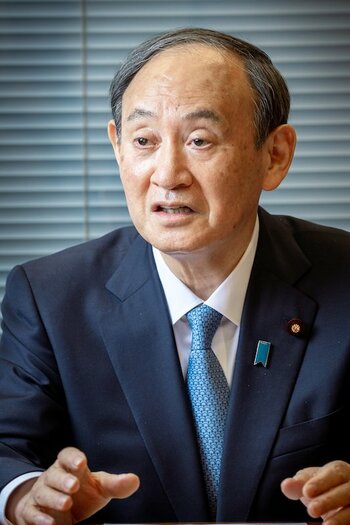Originally published in Japanese on Mar. 16, 2022
Snubbing MOF
OGURA: Immediately after Prime Minister Fumio Kishida assumed office, his comments triggered a slump in the stock market that some dubbed the “Kishida shock.” Market participants took a dim view of his prioritization of distribution and his disregard for the stock market. So, I would like to ask about the management of the economy during your time as chief cabinet secretary in the Abe administration and then as prime minister. How much emphasis was placed on stock prices and economic growth during the Abe and Suga administrations?
 Photo by Masato Kato
Photo by Masato Kato
SUGA: Naturally, they were top priorities. When the Abe administration began in December 2012, stock prices were about 10,000 yen ($80 at the current exchange rate) and the exchange rate was hovering around 80 yen to the dollar. Japanese companies found it difficult to grow in these conditions.
I believe the “three arrows” of Abenomics, that is, monetary easing, fiscal stimulus and structural reforms, laid out by former Prime Minister Shinzo Abe were absolutely correct. Because we employed all available economic policies, stock prices remained solid, and the exchange rate corrected itself.
As chief cabinet secretary, I conducted the daily press conferences. When asked by reporters about the change from a strong yen to a weak yen, I repeatedly said it was a “correction of the excessively strong yen.” After that, the Ministry of Finance (MOF) told me, “Considering the balance of exports and imports, this is just about right. Please don’t say anything more about ‘correcting the excessively strong yen’ at the press conferences.”
I have always kept a close eye on exchange rates, interest rates and stock prices. I believed the correction still had not gone far enough, so I pushed aside the Finance Ministry’s request and kept saying that it was a “correction of the excessively strong yen.” (Laughs) That way, we communicated through the media that the Japanese government is committed to correcting the strong yen.
I also made the statements with the full understanding of Prime Minister Abe.
OGURA: It was also the Abe administration that changed the investment policy and portfolio of the GPIF (the Government Pension Investment Fund, which manages public pensions). While reporting for an economic magazine, I saw firsthand how a certain share of the 120 trillion yen it managed in 2014 was injected into the domestic market, resulting in the market bottoming out.
SUGA: That’s right. We did everything we could to spur growth.
In 2014, we changed the pension management. Until then, the fund's investment portfolio was 60% domestic bonds, 12% domestic stocks, 11% foreign bonds, 12% foreign stocks and 5% short-term assets. This was changed to 35% domestic bonds, 25% domestic stocks, 15% foreign bonds, and 25% foreign stocks.
Now (for the five years from April 1, 2020), the share of domestic bonds has been further reduced to 25% domestic bonds, 25% domestic stocks, 25% foreign bonds, and 25% foreign stocks.
Takatoshi Ito, a professor at the National Graduate Institute for Policy Studies (at Columbia University in the U.S.), was asked to head an expert advisory group that set a new direction for GPIF.
OGURA: According to GPIF’s most recent announcement, in the third quarter of fiscal 2021, its annual rate of return since the start of its discretionary investment in fiscal 2001 was 3.9%, with accumulated returns of 107.63 trillion yen and 199.25 trillion yen in assets under management. Most of the revenue came after the portfolio review under the Abe administration.
Amazed by Abe
SUGA: Besides the GPIF reforms, the administration took significant risks in pursuing structural reforms.
The Trans-Pacific Partnership (TPP) is a good example. In 2013, Abe met with then U.S. President Barack Obama at Abe’s first Japan-U.S. summit since taking office, and he received a request to join the TPP.
Within the LDP (Japan’s ruling Liberal Democratic Party), the general thinking was that there was no need to rush on the TPP because an upper-house election was coming up. But Abe’s thinking was, “If we’re going to do the TPP anyway, let’s get it done as far ahead of the election as possible.” I was amazed by his determination.
It is unfortunate that the U.S. still has not joined the TPP, but the Abe administration worked to advance many other free trade agreements with other partners, such as the Economic Partnership Agreement with the European Union, the bilateral U.S.-Japan Trade Agreement and the Regional Comprehensive Economic Partnership.
OGURA: How about the reforms of the Suga administration? In the post-COVID world, that is, after the pandemic subsides, in what fields can Japan achieve economic growth?
SUGA: Following the Abe administration, my administration developed an ambitious policy platform that had four main elements: green (environment), digital, measures to combat the falling birthrate and regional revitalization. We were determined to push forward with green and digital as the two main forces driving economic growth in Japan.
In my policy speech to the National Diet, I clearly said that "we will achieve 100% electric vehicles in new car sales by 2035.” In conjunction with achieving carbon neutrality by 2050, the government should take the lead in promoting sustainable economic development.
But Japan is lagging in the digital sector. The first step will be to use the Digital Agency as a command post to unify municipal systems and make them cloud-capable, improving operational efficiency.
I mentioned them before, but the three arrows of Abenomics have returned the Japanese economy to its best performance since the bubble period. However, many obstacles still hinder economic growth in Japan, and will continue to do so even in the post-COVID era. The biggest are administrative stove-piping, vested interests and an obsession with sticking to precedent. We have no alternative but to break down these barriers.
Social Media Smash
OGURA: As prime minister, you advanced a policy of allowing insurance to cover infertility treatments as a measure to address the falling birthrate. From April this year these procedures will be covered by insurance. It is not discussed widely, but this is a ground-breaking development. Coverage will include treatments for both female and male infertility, as well as 16 more drugs, including Viagra and Cialis for erectile dysfunction.
SUGA: When we announced this policy on Twitter, we received about 150,000 likes — 200,000 if you include related posts. Honestly, I was surprised. I think this is an indication of the public’s favorable view of the policy.
OGURA: How about regional revitalization?
SUGA: Consumption in the core of the Tokyo Metropolitan Area, which includes Tokyo, Kanagawa, Chiba and Saitama prefectures, accounts for only 30% of the national total. The remaining 70% is “regional.” If we do not raise incomes in regions outside of Tokyo to stimulate more consumption, Japan as a whole will stagnate. I believe the three keys to regional revitalization are the hometown tax payment system, expanding agricultural exports and reviving inbound tourism.
The hometown tax payment system was actually created when I was minister of internal affairs and communications, and it began operating in fiscal 2008. By donating to a municipality of your choice, you can deduct some of your income tax and municipal taxes and, if you choose, receive a gift in return from that municipality.
There was various pushback, but awareness has spread among the public, and in fiscal 2020 there was over 672.4 billion yen in donations. Last year donations grew by 30%, and I believe they exceeded 800 billion yen. If this trend continues, it is only a matter of time until they cross the 1-trillion-yen threshold.
Growing agricultural exports is linked to the promotion of free trade agreements. Japanese agricultural exports are very popular overseas, especially in Asia. Japanese beef and strawberries, for example, are by all accounts the best.
We designated these goods as important commodities and provided support to producing areas. At the start of the Abe administration, the export value of agricultural, forestry and fishery products and foodstuffs was about 450 billion yen, but last year it reached about 1.25 trillion yen. I hope that we can make progress toward the next goal of 2 trillion yen by 2025.
And then there is inbound tourism. The COVID-19 pandemic has been devastating, but in 2019 there were over 31.88 million overseas visitors to Japan, up from 8.35 million in 2012. Japan has abundant tourism resources, and it is easy to imagine that an explosive number of people will come to Japan in the post-COVID era.
France, a powerhouse in the tourism sector, had 89 million visitors for a population of about 67 million (2017). Considering Japan’s tourism resources, which are said to be comparable to those of France, I believe that the number of tourists coming to Japan could exceed the Japanese population of 120 million.
(Originally written in Japanese by Kenichi Ogura, translated and edited by Connor Cislo)









